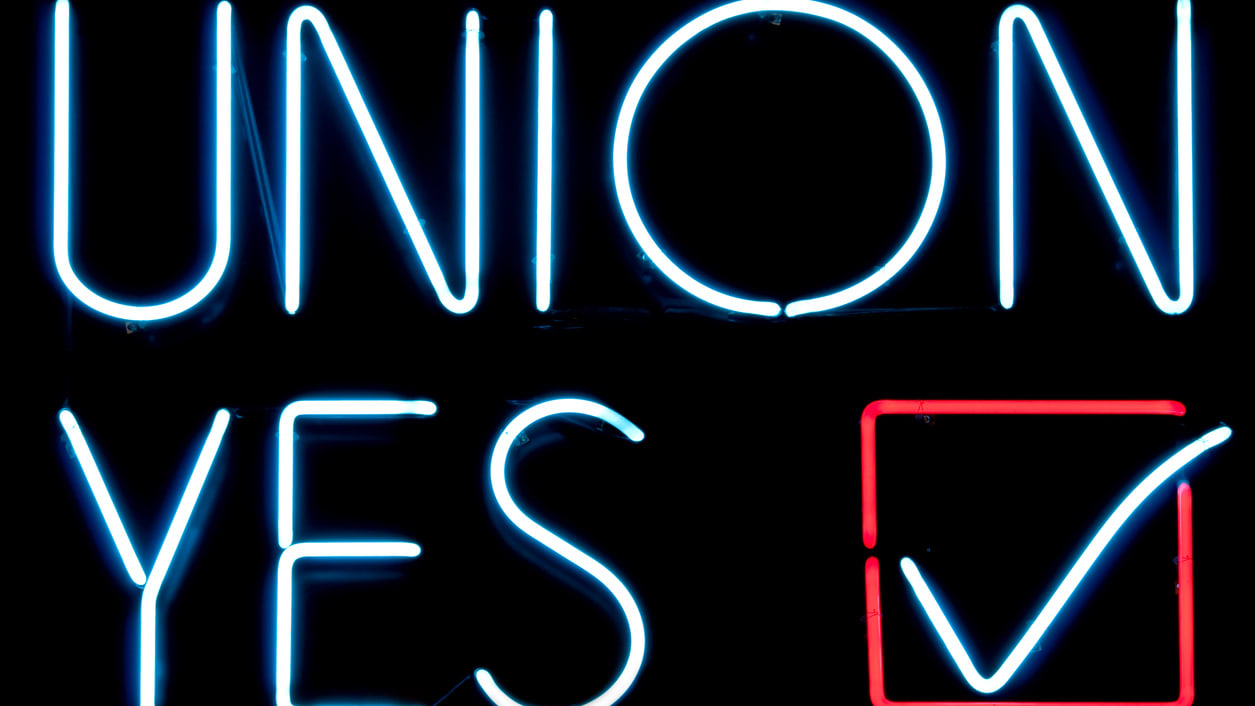Managers and business consultants are reporting an uptick in labor organizing during the COVID-19 pandemic, a byproduct of increased workplace frustrations and a political climate that is tilting in favor of unions.
The highest-profile of this organizing seems to be in the tech sector. Amazon warehouse workers in Alabama began voting the week of Feb. 8 on whether to unionize, and workers at Google recently set up a minority union. Amazon workers have until the end of March to vote.
The pandemic is also fueling a renewed interest in unions among health care workers. "The urgency and desperation we've heard from workers is at a pitch I haven't experienced before in my 20 years of this work," Cass Gualvez, a Service Employees International Union organizing director, told NPR in September. "We've talked to workers who said, 'I was dead set against a union five years ago, but COVID has changed that.' "
Phil Wilson, president and general counsel of the Labor Relations Institute in Broken Arrow, Okla., said that union petitions will likely ramp up as the country emerges from COVID-19 shutdowns. "I also think unions will be energized by changes in the Biden administration that have already begun, but [they] will accelerate once the National Labor Relations Board gains a Democratic majority toward the end of the year."
For managers, an uptick in unionization means they need to be more vigilant and aware of dissatisfaction among their workers, according to workplace experts.
"Now, more than ever, companies need to be focused on strengthening their organizational culture, and strengthening their employee relations, especially via strong communication," said David Pryzbylski, a labor and employment attorney at Barnes & Thornburg LLP in Indianapolis.
Pryzbylski noted that employees' perception that their company does not care about them or is not sharing information critical to job security "exponentially heightens" the risk of an organizing drive and the chances that the organizing drive will result in a union vote. These possibilities are especially ripe when people are working remotely in far-flung locations during the pandemic and not interacting with managers.
"In my experience, those types of issues, rather than monetary considerations, are almost always the motivators in terms of a unionization effort," Pryzbylski said. "Whether a company is facing a current organizing drive or is just looking to better insulate itself, ensuring your employees know you care about them is key."
For instance, employees should know the steps managers are taking to ensure their workers' job security and health during the pandemic. Communicating workplace and business plans during the pandemic and for the longer term is particularly critical now.
In addition, managers need to think about how they will communicate with workers, given social distancing expectations, during a unionization campaign, Pryzbylski said.
One of the most effective campaign tools to counter union elections are often large, in-person, all-employee meetings with management (also known as "captive audience meetings"). But pandemic social-distancing restraints generally limit meeting sizes, and many employees may feel uncomfortable or unsafe sitting in close proximity to others. This is a tool managers may not be able to use for the foreseeable future.
"Social media, video messaging and other mediums may have to be considered as primary communications vehicles," Pryzbylski said.
Jon Hyman, a labor and employment attorney at Meyers Roman Friedberg & Lewis based in Cleveland, agreed. "Supervisors and managers need to pay attention to what's going on with employees," he said. "Managers need to be very careful, as surveillance and interrogation of employees related to union organizing activity is illegal under the National Labor Relations Act [NLRA]."
Indeed, management consultants say that in a political era of potentially strict enforcement of labor laws, it is important that managers are mindful of limits on what companies can say to employees during a union campaign under the NLRA.
For example, managers cannot make any statements that threaten employees with adverse consequences related to their union views; they cannot interrogate workers about their union views; they cannot promise benefits to employees in exchange for not supporting the union; they cannot engage in surveillance on employee union efforts; and they cannot create the impression a company is "spying" on such efforts.
"Crossing the line can have negative consequences for a company, such as being forced to rerun an election it won, or even being forced to recognize the union in the absence of a majority of employees voting for the union if violations are severe," Pryzbylski said. "Accordingly, a best practice is to vet all planned campaign communications with someone with legal experience in this context so a company doesn't inadvertently shoot itself in the foot."
Holly Rosenkrantz is a freelance writer based in Washington, D.C.




